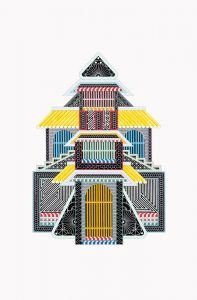Renee Gladman and Edie Fake in Paris Review:
 It was in the third of the essays I was writing on how we’d come to see the cities of the future as cities of the future (something to refocus our attention on, now that the cities of the future of the past, the structures in which we were all living, had been thoroughly codified and photographed and renovated, resold as more shimmering or more minimalist versions of themselves then rephotographed, and we were liking the reiterations on our Instagrams, enjoying this incredible proximity to architecture: I was an architect, writing about architecture in my poems), but it was hard to deny that we’d reached that time in our respective chronologies when cities of the future was something that had to be reenvisioned and discussed as you sat under studio lights in a narrow room of books in an office building and your talk was broadcast over the Internet (you were not of the technological elite, so you didn’t know that sitting hunched over would make you appear hunched over to anybody watching), but the idea of cities of the future came to everyone one night in our sleep and it was time to begin to think and talk about it, to try to envision what these would look like and who would occupy them and if they would have different names or exist on different planets (you had to be speculative but also had to weigh in on what was actually happening on your streets, in your bodies, and between bodies): it was in number three of the essays that I began to see color as that which would make our cities of the future cities of the future and this was thanks to Edie Fake, whose renditions of the architectures of our new cities performed like an architecture finally taking into account our clothes. I began writing the essays about the cities of the future, starting with weather and invisibility—cities of the future, their weather; then cities of the future, invisibility—and I began each never considering that the cities of the future had color, and not only color but very bright color that was not only very bright but patterned as well.
It was in the third of the essays I was writing on how we’d come to see the cities of the future as cities of the future (something to refocus our attention on, now that the cities of the future of the past, the structures in which we were all living, had been thoroughly codified and photographed and renovated, resold as more shimmering or more minimalist versions of themselves then rephotographed, and we were liking the reiterations on our Instagrams, enjoying this incredible proximity to architecture: I was an architect, writing about architecture in my poems), but it was hard to deny that we’d reached that time in our respective chronologies when cities of the future was something that had to be reenvisioned and discussed as you sat under studio lights in a narrow room of books in an office building and your talk was broadcast over the Internet (you were not of the technological elite, so you didn’t know that sitting hunched over would make you appear hunched over to anybody watching), but the idea of cities of the future came to everyone one night in our sleep and it was time to begin to think and talk about it, to try to envision what these would look like and who would occupy them and if they would have different names or exist on different planets (you had to be speculative but also had to weigh in on what was actually happening on your streets, in your bodies, and between bodies): it was in number three of the essays that I began to see color as that which would make our cities of the future cities of the future and this was thanks to Edie Fake, whose renditions of the architectures of our new cities performed like an architecture finally taking into account our clothes. I began writing the essays about the cities of the future, starting with weather and invisibility—cities of the future, their weather; then cities of the future, invisibility—and I began each never considering that the cities of the future had color, and not only color but very bright color that was not only very bright but patterned as well.
However, you couldn’t get to these cities until you sufficiently saw the houses that composed them.
More here.
